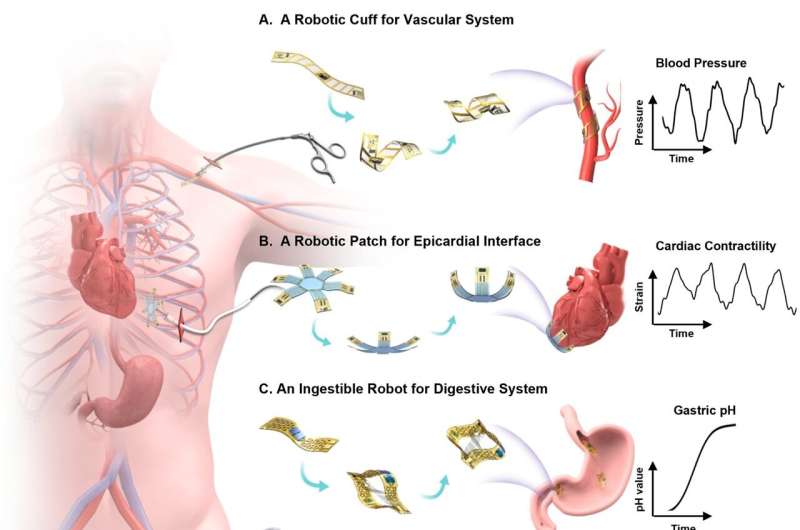This article has been reviewed according to Science X's editorial process and policies. Editors have highlighted the following attributes while ensuring the content's credibility:
fact-checked
peer-reviewed publication
trusted source
proofread
Researchers create skin-inspired sensory robots to provide medical treatment

University of North Carolina at Chapel Hill scientists have created innovative soft robots equipped with electronic skins and artificial muscles, allowing them to sense their surroundings and adapt their movements in real-time, according to a paper titled "Skin-Inspired, Sensory Robots for Electronic Implants," in Nature Communications.
In their research, the robots are designed to mimic the way muscles and skin work together in animals, making them more effective and safer to use inside the body. The e-skin integrates various sensing materials, such as silver nanowires and conductive polymers within a flexible base, closely resembling the complex sensory functions of real skin.
"These soft robots can perform a variety of well-controlled movements, including bending, expanding and twisting inside biological environments," said Lin Zhang, first author of the paper and a postdoctoral fellow in Carolina's Department of Applied Physical Sciences. "They are designed to attach to tissues gently, reducing stress and potential damage. Inspired by natural shapes like starfish and seedpods, they can transform their structures to perform different tasks efficiently."
These features make soft sensory robots highly adaptable and useful for enhancing medical diagnostics and treatments. They can change shape to fit organs for better sensing and treatment; are capable of continuous monitoring of internal conditions, like bladder volume and blood pressure; provide treatments, such as electrical stimulation, based on real-time data; and can be swallowed to monitor and treat conditions in the stomach.
An ingestible robot capable of residing in the stomach called a thera-gripper, can monitor pH levels and deliver drugs over an extended period, improving treatment outcomes for gastrointestinal conditions. The thera-gripper can also gently attach to a beating heart, continuously monitoring electrophysiological activity, measuring cardiac contraction and providing electrical stimulation to regulate heart rhythm.
A robotic gripper designed to wrap around a person's bladder can measure its volume and provide electrical stimulation to treat the overactive one, enhancing patient care and treatment efficacy. A robotic cuff that twists around a blood vessel can accurately measure blood pressure in real time, offering a non-invasive and precise monitoring solution.
"Tests on mice have demonstrated the thera-gripper's capability to perform these functions effectively, showcasing its potential as a next-generation cardiac implant," said Zhang.
The Bai Lab collaborated on the study with UNC-Chapel Hill researchers in the Department of Biology; Department of Biomedical Engineering; Department of Chemistry; Joint Department of Biomedical Engineering and McAllister Heart Institute; North Carolina State University; and Weldon School of Biomedical Engineering at Purdue University.
The researchers' success in live animal models suggests a promising future for these robots in real-world medical applications, potentially revolutionizing the treatment of chronic diseases and improving patient outcomes.
"This innovative approach to robot design not only broadens the scope of medical devices but also highlights the potential for future advancements in the synergistic interaction between soft implantable robots and biological tissues," said Wubin Bai, principal investigator of the research and Carolina assistant professor. "We're aiming for long-term biocompatibility and stability in dynamic physiological environments."
More information: Lin Zhang et al, Skin-inspired, sensory robots for electronic implants, Nature Communications (2024). DOI: 10.1038/s41467-024-48903-z





















